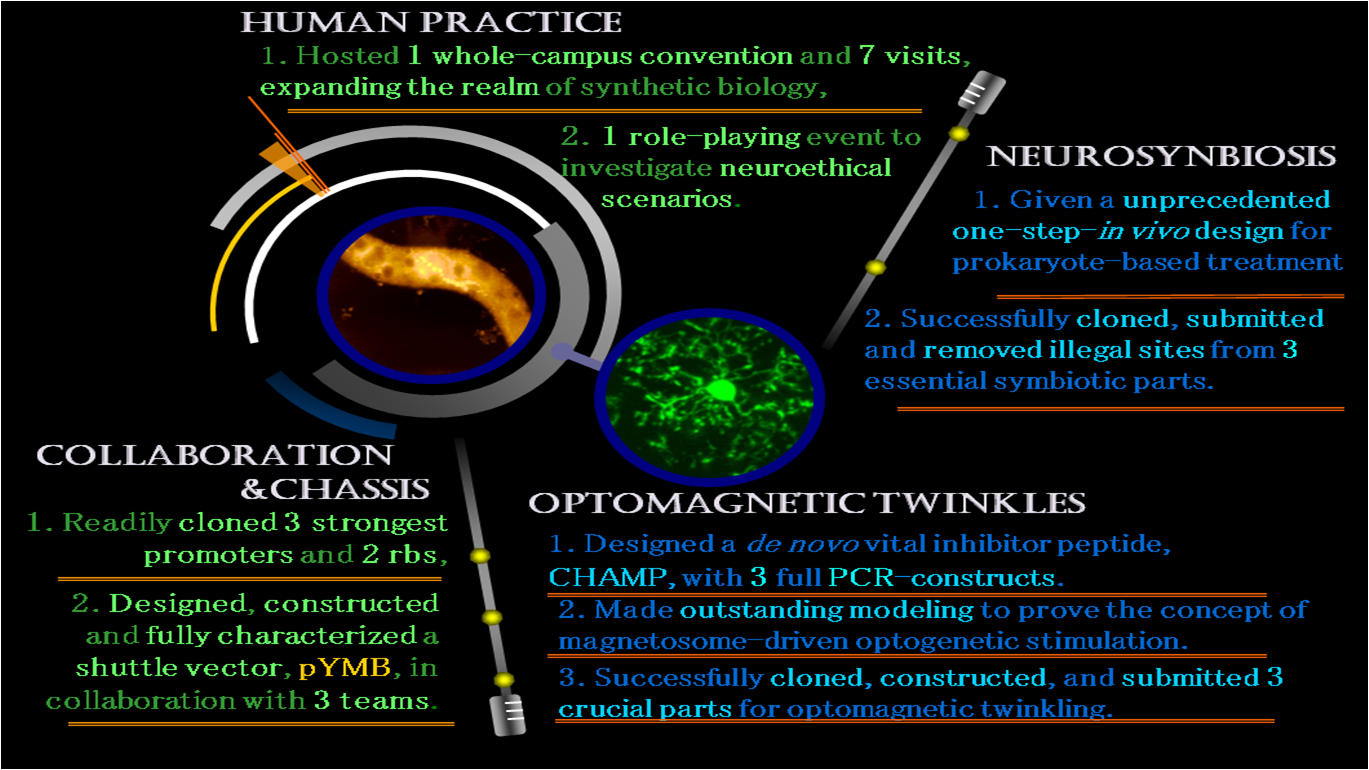Team:NYMU-Taipei/Our institute
From 2011.igem.org
(Difference between revisions)
| (11 intermediate revisions not shown) | |||
| Line 3: | Line 3: | ||
<font size=2> | <font size=2> | ||
| - | To achieve this goal, we use a species of magnetic bacteria, Magnetospirillum magneticum AMB-1. We have chosen mms13, a transmembrane protein as our target for protein design, as it serves as a linker between reception of wireless magnetic field and optogenetic neuro-stimulation output. Regarding the neuroimmune response, we choose three genes to achieve symbiosis within glial cell: ''MinC'', a division inhibitor, ''INV'', a gene for invasion and ''LLO'', a gene for facilitated escape from phagosomes.</font> | + | To achieve this goal, we use a species of magnetic bacteria,'' Magnetospirillum magneticum'' AMB-1. We have chosen mms13, a transmembrane protein as our target for protein design in this bacterium, as it serves as a linker between reception of wireless magnetic field and optogenetic neuro-stimulation output. Regarding the neuroimmune response, we choose three genes to achieve symbiosis within glial cell: ''MinC'', a division inhibitor, ''INV'', a gene for invasion and ''LLO'', a gene for facilitated escape from phagosomes.</font> |
| - | *'''<font size=3>Our design is made up of following two devices:</font>'''<br> | + | |
| + | *'''<font size=3>Our design is made up of the following two devices:</font>'''<br> | ||
<font size=2> | <font size=2> | ||
*[https://2011.igem.org/Team:NYMU-Taipei/optomagnetic-design Optomagnetic Design] | *[https://2011.igem.org/Team:NYMU-Taipei/optomagnetic-design Optomagnetic Design] | ||
| - | ** | + | **Bridge magnetics and optogenetics |
| - | *[https://2011.igem.org/Team:NYMU-Taipei/immunological-solution | + | *[https://2011.igem.org/Team:NYMU-Taipei/immunological-solution NeuroSymbiosis] |
**Make magnetic bacteria symbiosis with glia cell | **Make magnetic bacteria symbiosis with glia cell | ||
| + | </font> | ||
| + | |||
| + | *'''<font size=3>Achievements</font>''' | ||
| + | <font size=2> | ||
| + | <center>[[image:Achievement.png|900px|]]</center> | ||
| + | |||
</font> | </font> | ||
*'''<font size=3>Our institute</font>''' | *'''<font size=3>Our institute</font>''' | ||
| Line 16: | Line 23: | ||
** [http://web.ym.edu.tw/front/bin/home.phtml in Chinese] | ** [http://web.ym.edu.tw/front/bin/home.phtml in Chinese] | ||
** [http://nymu-e.web.ym.edu.tw/front/bin/home.phtml in English] | ** [http://nymu-e.web.ym.edu.tw/front/bin/home.phtml in English] | ||
| - | * | + | * Follow the two links below to see <font color="red">'''The Beauty of NYMU'''</font> |
** [http://issue.ym.edu.tw/cia/new/ Take a panoramic scenery view of our university] | ** [http://issue.ym.edu.tw/cia/new/ Take a panoramic scenery view of our university] | ||
** [http://issue.ym.edu.tw/cia/new/tw/ym720.html Take a tour of our university] | ** [http://issue.ym.edu.tw/cia/new/tw/ym720.html Take a tour of our university] | ||
</font> | </font> | ||
Latest revision as of 19:17, 28 October 2011
- Our design
To achieve this goal, we use a species of magnetic bacteria, Magnetospirillum magneticum AMB-1. We have chosen mms13, a transmembrane protein as our target for protein design in this bacterium, as it serves as a linker between reception of wireless magnetic field and optogenetic neuro-stimulation output. Regarding the neuroimmune response, we choose three genes to achieve symbiosis within glial cell: MinC, a division inhibitor, INV, a gene for invasion and LLO, a gene for facilitated escape from phagosomes.
- Our design is made up of the following two devices:
- Optomagnetic Design
- Bridge magnetics and optogenetics
- NeuroSymbiosis
- Make magnetic bacteria symbiosis with glia cell
- Achievements

- Our institute
- The official web pages of our school - National Yang Ming University (NYMU):
- [http://web.ym.edu.tw/front/bin/home.phtml in Chinese]
- [http://nymu-e.web.ym.edu.tw/front/bin/home.phtml in English]
- Follow the two links below to see The Beauty of NYMU
- [http://issue.ym.edu.tw/cia/new/ Take a panoramic scenery view of our university]
- [http://issue.ym.edu.tw/cia/new/tw/ym720.html Take a tour of our university]
 "
"